Computer Networking Lecture Notes
2014 October 27 • Local Area Networks
Outline
- Shared wire media.
- Ethernet switches.
- Combined LANs.
- At layer 2 or 3.
Data-Link Networks
- The data-link layer groups hosts into two types of networks:
- Point-to-point networks.

- Shared-channel networks.

- Point-to-point networks.
Local-Area Networks
- A shared-channel network is commonly called Local-Area Network (LAN).
- “Local area”:
- Limited geographical coverage (up to a square mile).
- Limited host population (up to a few hundred hosts).
Shared Channel
- Most modern high-capacity LANs don’t use shared-channel media.
- Too expensive: sharing coordination overhead.
- Too inefficient: conflict resolution overhead.
Switched Ethernet
- The most common wired LAN is switched Ethernet.
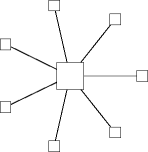
- A star architecture.
- Hosts around the outside.
- A LAN switch in the middle.
- Point-to-point links connecting them.
- A star architecture.
LAN Switches
- A LAN (or layer-2) switch forwards PDUs among connected hosts.
- There are no collisions.
- Incoming PDUs are buffered at the switch.
- Links are full duplex.
- There is no direct connection (no circuit) between hosts.
LAN Switch Forwarding
- A LAN switch forwarding table is a list of (destination, port) pairs.
- Entries are aged.
- A PDU arrives at a switch port.
- If the destination MAC address is not in the forwarding table, flood the PDU.
- Otherwise send the PDU out the designated port.
- The star architecture means flooding is trivial.
Forwarding Example
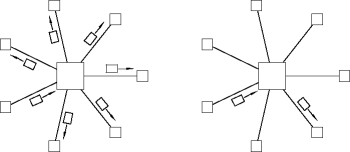
PDU Snooping
- Switch forwarding tables are self-discovered.
- A PDU from MACs shows up on port i.
- Put (MACs, i) in the forwarding table.
- Or reset the aging timer if it’s already there.
- No set-up, no routing algorithms.
- But non-sending hosts don’t get discovered.
Connecting LANs
- A LAN per department is a convenient network layout.
- Traffic and fault isolation.
- On the other hand, communication between departments is also nice.
- LANs can be connected at the data-link layer, or at the network layer.
Network-Connected LANs
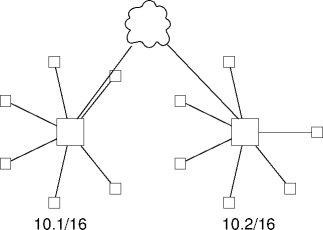
Comments
- Flexible and scalable interconnect.
- Can grow to connect 100s of LANs.
- Allows communication, but preserves LAN structure.
- Each component LAN remains a separate entity.
- But network management is difficult and labor intensive.
Data-Link-Connected LANs
- Forget the network layer and connect at the data-link layer.
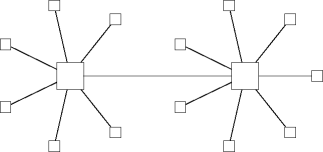
Comments
- Much simpler than network connections, but not as scalable.
- Connect 10s of LANs.
- Large forwarding tables.
- One big LAN doesn’t preserve component LAN structure.
- Large drop in aggregate resource availability.
- Layer-2 switches help with this.
The Deadly Cycle
- Cycles provide redundant connectivity for reliability.
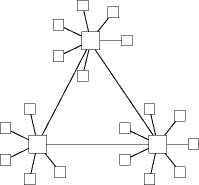
- Cycles can occur accidentally, particularly in large interconnected LANs.
Flooding and Cycles
- Switches flood when destinations aren’t known.
- Floods and cycles are a bad combination.
- Routers deal with this by not flooding.
- Switches avoid flooding problems using a different approach.
Spanning Trees
- A tree is an acyclic graph.
- Being acyclic, trees can flood PDUs without problems.
- No excessive PDU copying.
- The flood naturally dies down.
- A spanning tree is a tree containing every switch in the LAN.
- It spans the hosts in the LAN.
- The switches build a spanning tree.
Growing a Spanning Tree
- To build a spanning tree:
- Use flooding to select the root switch, the switch with the lowest MAC address.
- The root switch floods a path PDU.
- Switch S receiving the first path PDU marks the incoming port as the root port and floods the path PDU.
- S discards further path PDUs.
- The set of root ports forms a spanning tree.
Summary
- Shared wire media isn’t much shared anymore.
- Ethernet switches are layer 2 store and forward devices.
- LANs can be combined into larger structures.
- At layer 3 with routers.
- At layer 2 with switches.
| This page last modified on 2014 October 26. |
